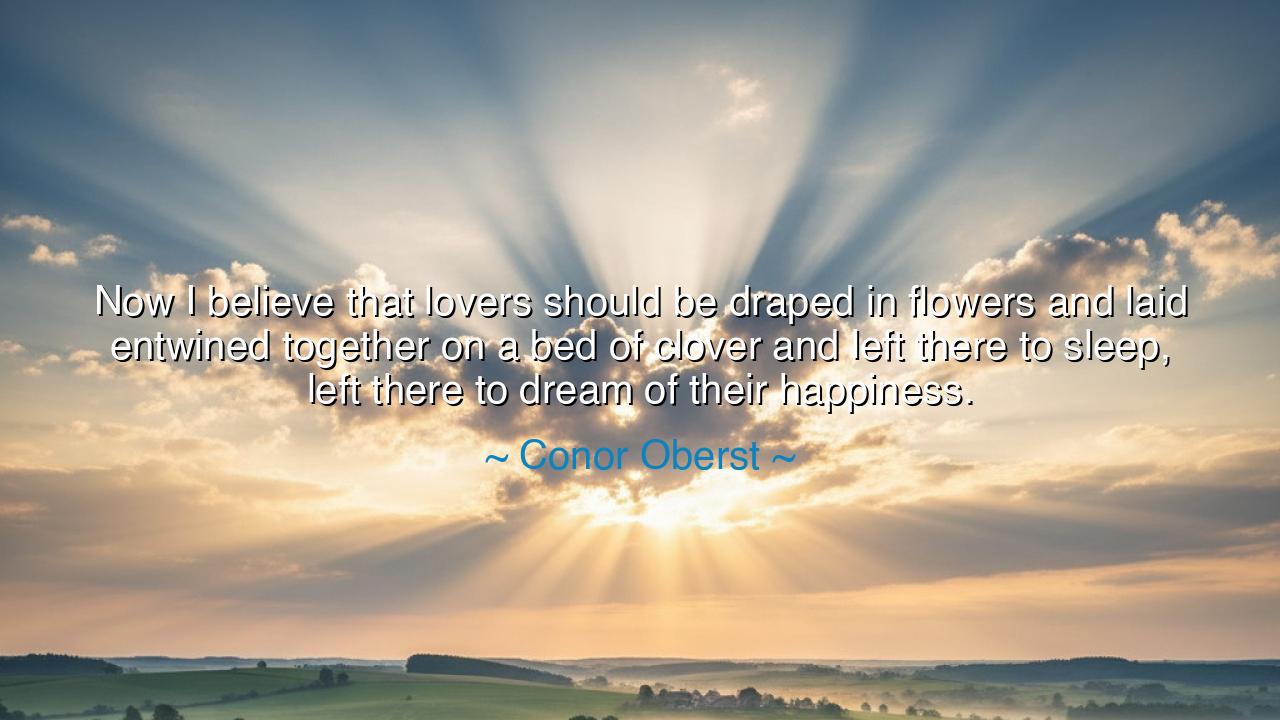
Now I believe that lovers should be draped in flowers and laid
Now I believe that lovers should be draped in flowers and laid entwined together on a bed of clover and left there to sleep, left there to dream of their happiness.






When Conor Oberst wrote, “Now I believe that lovers should be draped in flowers and laid entwined together on a bed of clover and left there to sleep, left there to dream of their happiness,” he was not simply speaking of romance, but of love in its most sacred, poetic, and eternal form. His words are tender and dreamlike, yet beneath their beauty lies a deep yearning—a wish to preserve the fragile perfection of love against the relentless passage of time. In this single image, Oberst captures what philosophers, poets, and dreamers have sought for millennia: the desire for love to remain uncorrupted, untouched by sorrow, decay, or change. To be “draped in flowers” and “laid on a bed of clover” is to be surrounded by nature’s gentleness, to be absorbed into the eternal cycle of life and beauty—two souls united not only in affection but in peace.
The origin of this sentiment lies in Oberst’s work as a songwriter and poet, where themes of love, loss, and mortality intertwine like vines in an ancient garden. His imagery draws upon the language of myth and ritual—flowers as symbols of purity and transience, clover as a token of luck, devotion, and the earth’s blessing. It is as though he envisions love as a sacred offering, a joining of two spirits so complete that they no longer need to strive, to speak, or to endure the struggles of the world. They are instead left to dream, their happiness sealed like a promise within nature’s eternal calm. It is a vision both romantic and elegiac, for it suggests that the truest happiness in love may lie not in endless passion, but in peace—the quiet after the storm of longing has passed.
There is a certain ancientness to this image, echoing the old rites and myths of lovers who became one with the earth. In the story of Orpheus and Eurydice, love sought to defy death, to hold onto happiness beyond its natural season—but the gods, and fate, forbade it. Oberst’s vision, by contrast, seems to accept the inevitability of life’s impermanence. He does not plead for love to conquer time; instead, he wishes for lovers to be granted a moment of perfect rest, frozen in their happiness, untouched by the world’s noise. This is not a denial of reality, but an acknowledgment of its beauty—that every bloom must fade, yet in fading, it fulfills its purpose. His words are like a prayer that love, in its truest form, may be remembered in that state of serene completion.
This sentiment finds reflection in the lives of real people, too. Consider John Keats, the young poet who lived and died by his love of beauty. Keats, who fell in love with Fanny Brawne but died too young to marry her, wrote in his letters of wishing to “cease upon the midnight with no pain,” to be captured in a perfect moment before time could mar it. His epitaph—“Here lies one whose name was writ in water”—speaks to the same truth that Oberst articulates: that love and happiness are transient, but their memory, their dream, endures forever. To wish for lovers to “sleep and dream of their happiness” is to honor that fleeting perfection, to let it live unspoiled in memory and art.
And yet, Oberst’s vision is not one of sorrow alone. There is hope in his words, a reverence for the sanctity of love that transcends even death. To be “draped in flowers” is not to be buried in despair, but to be celebrated, to be adorned by the symbols of renewal and rebirth. Flowers bloom again; clover returns with every spring. Thus, even as the lovers sleep, their happiness becomes part of the eternal rhythm of nature—a cycle of endings and beginnings, of fading and flourishing. In this way, Oberst teaches that love’s power does not die with the lovers themselves; it is absorbed into the world, into song, into memory, into the quiet persistence of beauty.
What makes this quote so moving is its acceptance—its recognition that love cannot be forced to remain unchanged. Many suffer because they try to hold onto love as it once was, not realizing that love, like all living things, must evolve or find rest. Oberst’s image offers a gentler wisdom: let love, when it has fulfilled its purpose, lie peacefully. Let it become a memory, a dream, a part of the earth’s eternal song. To cling to happiness too tightly is to crush it; to let it rest is to honor it. This is the art of loving with grace, of understanding that even endings are sacred when embraced with gratitude.
So, my children of the present age, learn from this vision: do not fear the changing forms of love. When it is passionate, let it burn; when it is gentle, let it flow; when it must rest, let it rest beautifully. Do not cling to happiness as if it were a possession, but let it pass through you as sunlight through leaves, warming you while it lasts. And when love must sleep—when it has said all it needs to say—lay it tenderly upon the bed of memory, draped in the flowers of gratitude and the clover of peace. For as Conor Oberst reminds us, the greatest love is not that which endures forever in time, but that which remains forever in spirit—a love so pure that even in its dreaming, it continues to bless the world.






AAdministratorAdministrator
Welcome, honored guests. Please leave a comment, we will respond soon